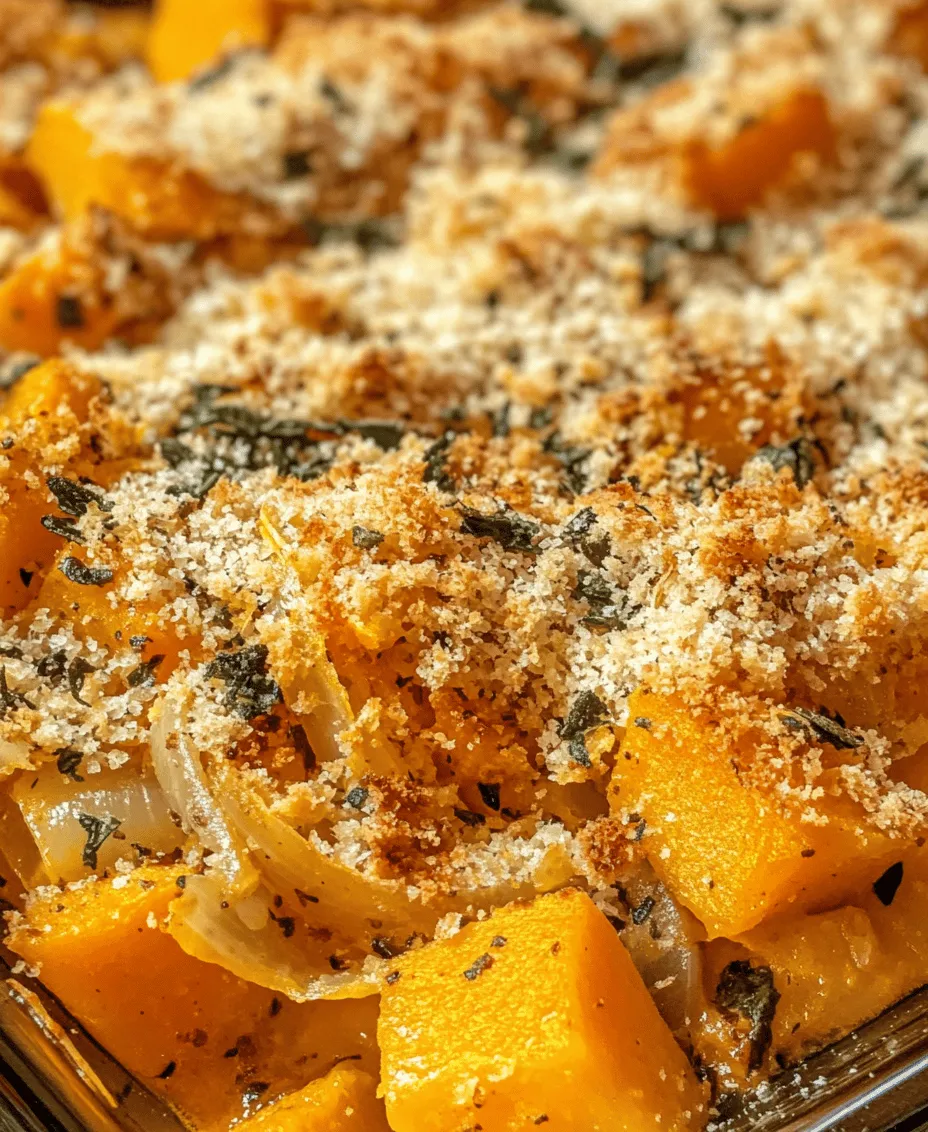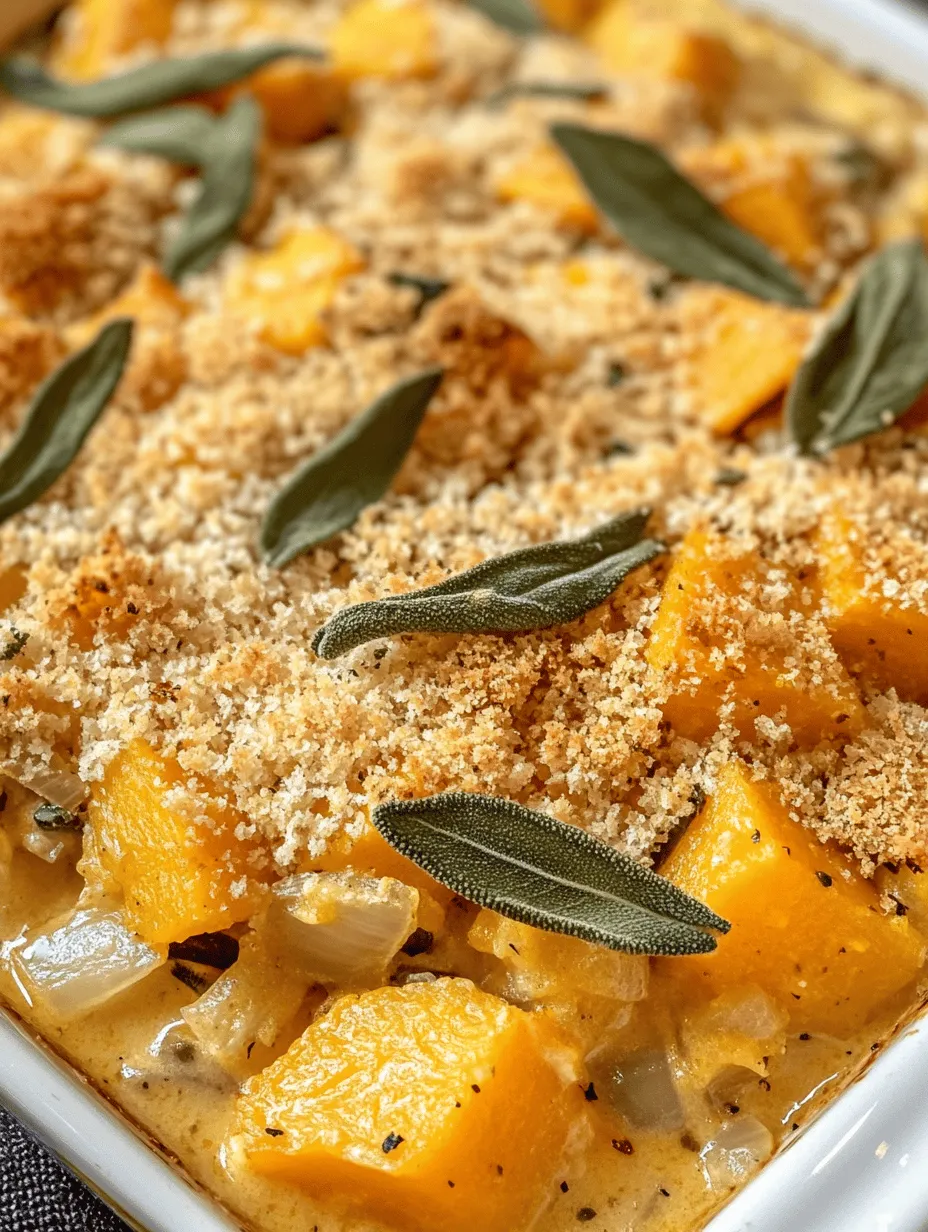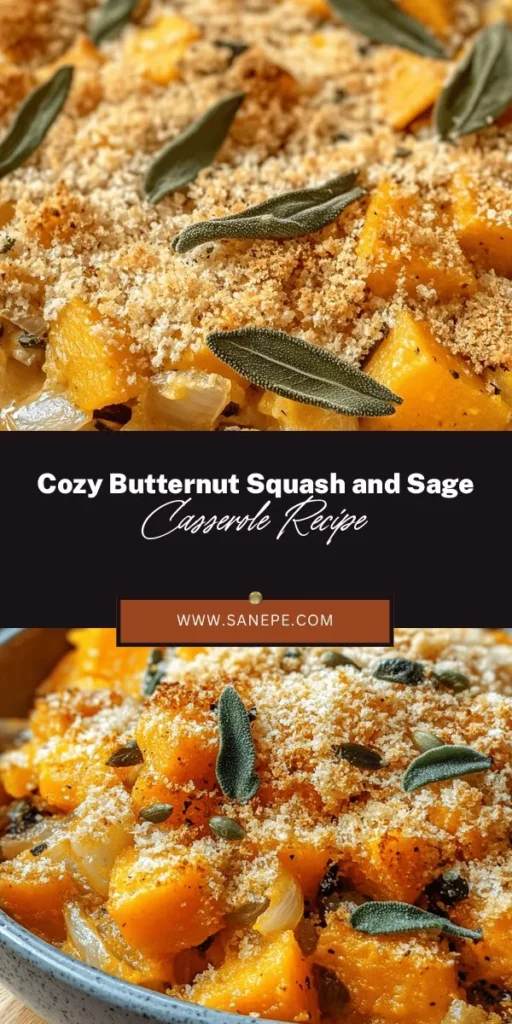Introduction
As the leaves turn and the air becomes crisp, the culinary world welcomes the comforting embrace of seasonal ingredients, with butternut squash leading the charge. This vibrant, sweet vegetable not only embodies the essence of autumn but also transforms into a delightful centerpiece for family gatherings and holiday meals. The Butternut Squash and Sage Casserole captures the heartwarming flavors of this time of year, combining the creamy, nutty notes of roasted squash with the aromatic, earthy tones of sage. Whether served as a side dish at Thanksgiving or as a warm, inviting dinner option, this casserole promises to be a favorite at your table.
Butternut squash is not only delicious but also packed with nutritional benefits. Rich in vitamins A and C, fiber, and antioxidants, it supports overall health and adds a colorful touch to your plate. Sage, a fragrant herb known for its culinary versatility, complements butternut squash perfectly, enhancing its natural sweetness while bringing additional health benefits to the dish. Together, they create a casserole that is not only satisfying but also nourishing, making it a perfect choice for those who want to enjoy wholesome, seasonal flavors.
Understanding Butternut Squash
Butternut squash is a winter squash that boasts a smooth, tan exterior and bright orange flesh. It is renowned for its sweet, nutty flavor, which deepens when roasted, making it a favorite ingredient in many autumn recipes. Nutritionally, butternut squash is a powerhouse. A cup serving provides an impressive amount of Vitamin A, which is essential for maintaining healthy vision, supporting the immune system, and promoting skin health. Additionally, its high fiber content aids digestion and helps to maintain a healthy weight.
When selecting butternut squash, look for those that feel heavy for their size and have a dull, matte finish. Avoid any with soft spots or blemishes, as these can indicate overripeness. Ideal butternut squash should have a firm texture and a deep, uniform color. It’s available from late summer through winter, making it a versatile ingredient for various recipes—whether roasted, pureed into soups, or baked in casseroles like this one.
The versatility of butternut squash doesn’t stop at just savory dishes; it can also be used in desserts, adding natural sweetness to pies and cakes. Its adaptability makes it a must-have in your fall cooking repertoire.
The Role of Sage in Cooking
Sage is an aromatic herb that has been used in cooking for centuries, prized for its strong flavor and health benefits. With its slightly peppery and earthy taste, sage pairs exceptionally well with rich ingredients like butternut squash, enhancing its sweetness and adding depth to the dish. In this casserole, sage not only contributes to the overall flavor profile but also brings its own array of health benefits. Sage has been traditionally used to aid digestion, reduce inflammation, and even improve memory and cognitive function.
When it comes to using sage in cooking, there are two primary forms: fresh and dried. Fresh sage has a more potent flavor and a fragrant aroma, making it ideal for dishes where the herb’s essence can shine through. Dried sage, on the other hand, has a more concentrated flavor, and it’s often used in recipes where cooking processes can mellow its intensity. For this butternut squash and sage casserole, using fresh sage is recommended to achieve that vibrant, aromatic quality, though dried sage can be a suitable alternative if fresh is unavailable.
Ingredients Breakdown
To create the perfect Butternut Squash and Sage Casserole, it’s essential to gather the right ingredients. Here’s a detailed breakdown:
– Butternut Squash: The star of the dish. Start with a medium-sized butternut squash, which should be peeled, seeded, and cut into 1-inch cubes. Roasting the cubes brings out their natural sweetness and creates a tender, creamy texture that serves as the foundation of the casserole.
– Onion and Garlic: These aromatics are crucial for building flavor. A medium onion, diced, will add sweetness and depth, while minced garlic introduces a fragrant, savory note.
– Vegetable Broth: This adds moisture and enhances the flavors. You can use homemade vegetable broth for a richer taste or opt for store-bought for convenience.
– Heavy Cream: This ingredient brings richness to the dish, giving it a creamy texture. For a lighter version, consider using half-and-half or a plant-based cream.
– Parmesan Cheese: This cheese adds a savory umami flavor and a bit of saltiness. Grated Parmesan can be sprinkled on top for a golden, crispy finish. If you’re looking for a vegetarian option, ensure the cheese is made without animal rennet, or substitute with a vegan cheese.
– Breadcrumbs: Using fresh breadcrumbs will yield the best texture. Combine them with a bit of olive oil to create a crunchy topping that contrasts beautifully with the creamy squash.
– Olive Oil: A healthy fat that enhances the flavor and helps to roast the squash evenly. It’s an essential ingredient that contributes to the dish’s overall richness.
– Optional Ingredients: For an added crunch and a touch of color, consider garnishing with toasted pumpkin seeds. These not only add texture but also nutritional benefits, including healthy fats and protein.
Step-by-Step Instructions
Preheating the Oven
Before diving into the preparation, it’s essential to preheat your oven to 400°F (200°C). This ensures that the butternut squash will roast evenly and develop a lovely caramelization, which enhances its natural sweetness. A hot oven is key to achieving the perfect texture in your casserole, making it crispy on top while remaining soft and creamy inside.
By following these guidelines and preparing the ingredients with care, you’re setting the stage for a delightful Butternut Squash and Sage Casserole that will be the highlight of any meal. The combination of flavors and textures in this dish reflects the essence of autumn, making it a must-try recipe for both seasoned cooks and newcomers alike. As we move forward, we’ll delve into the detailed steps that will guide you through the process of creating this comforting casserole, ensuring that every bite is a celebration of seasonal goodness.

Importance of Oven Temperature for Even Cooking
Achieving the perfect texture and flavor in your butternut squash and sage casserole begins with the right oven temperature. Preheating your oven to 375°F (190°C) is essential for ensuring that the casserole cooks evenly throughout. An adequately preheated oven allows the ingredients to roast and meld together beautifully, creating a harmonious blend of flavors. If the oven is not hot enough, the casserole may end up soggy, and if it’s too hot, the top may brown too quickly while the inside remains undercooked. Always use an oven thermometer to confirm your oven’s accuracy, as many ovens can be off by several degrees.
Sautéing the Vegetables
Sautéing is a critical step in developing the rich flavors of your butternut squash and sage casserole. Start by heating a tablespoon of olive oil in a large skillet over medium heat. Once the oil is shimmering, add finely chopped onions and minced garlic.
Tips for Sautéing Onions and Garlic to Enhance Flavor
1. Timing: Add the onions first, allowing them to cook for 4-5 minutes until they become translucent and fragrant. Then, add the minced garlic and sauté for an additional 1-2 minutes. Garlic can burn quickly, so keep an eye on it to prevent bitterness.
2. Season Early: Season the onions with a pinch of salt while they cook. This will help draw out moisture and enhance sweetness.
3. Deglazing: After the onions and garlic are perfectly sautéed, consider deglazing the pan with a splash of vegetable broth or white wine. This not only lifts the flavorful bits stuck to the bottom but also adds depth to your casserole.
Cooking the Butternut Squash
Once your vegetables are sautéed, it’s time to cook the butternut squash.
Techniques for Ensuring the Squash is Tender and Flavors are Absorbed
1. Preparation: Peel and cube the butternut squash into uniform pieces, about 1-inch cubes, to ensure even cooking. If you’re short on time, you can look for pre-cut squash in the grocery store.
2. Blanching: To speed up the cooking process and ensure tenderness, consider blanching the cubed squash in boiling water for 3-5 minutes before adding it to the casserole. Drain and shock in ice water to stop the cooking process, then drain again.
3. Flavor Infusion: Add the cubed squash to the skillet with the sautéed onions and garlic. Season with salt, pepper, and half of the fresh sage. Sauté for about 10 minutes until the squash starts to soften and absorbs the flavors of the sautéed vegetables.
Combining Ingredients
Next, it’s essential to combine all the ingredients thoroughly to ensure an even distribution of flavors.
Importance of Mixing Sage and Cream Thoroughly for Flavor Distribution
In a separate bowl, mix heavy cream with the remaining sage, a touch of nutmeg, and a pinch of salt. Pour this mixture over the sautéed vegetables and squash. Stir gently to ensure that every piece of squash is coated with the creamy sage mixture. This step is crucial, as it allows the flavors to meld beautifully during baking, ensuring that every bite is rich and flavorful.
Assembling the Casserole
Layering is key to a delicious casserole.
Layering Techniques to Enhance Flavor Melding During Baking
1. Initial Layer: Start by spreading half of the butternut squash mixture evenly in a greased baking dish. This forms the base layer and prevents sticking while providing a solid foundation.
2. Second Layer: Sprinkle half of the grated cheese (if using) over the first layer. Cheese adds creaminess and flavor as it melts.
3. Final Layer: Top with the remaining squash mixture and finish with the rest of the cheese. This layered approach not only enhances the flavor but also ensures a beautiful presentation once baked.
Preparing the Breadcrumb Topping
A crunchy topping adds a delightful textural contrast to the creamy casserole.
Ideas for Adding Flavor to Breadcrumbs (Herbs, Spices)
1. Herbs and Cheese: Mix panko breadcrumbs with minced fresh herbs like parsley or thyme, and add grated Parmesan for a savory kick.
2. Spices: Consider adding a sprinkle of smoked paprika or garlic powder for added depth of flavor.
3. Butter: Drizzle melted butter over the breadcrumb mixture before sprinkling it on top of the casserole. This will help the breadcrumbs brown beautifully in the oven.
Baking the Casserole
Baking is the final step to bring all the flavors together.
Discussing the Importance of Baking Time and Monitoring for Doneness
Bake the casserole in the preheated oven for 30-35 minutes, or until the top is golden brown and the edges are bubbling. To ensure even cooking, rotate the casserole midway through baking. If the top browns too quickly, cover it loosely with aluminum foil for the remainder of the cooking time. To test for doneness, insert a knife into the center of the casserole; it should slide easily through the squash.
Serving Suggestions
Presentation can elevate your dish from ordinary to extraordinary.
Presentation Ideas and Pairing Suggestions (Salads, Sides)
1. Garnish: Before serving, garnish the casserole with fresh sage leaves or a sprinkle of freshly grated Parmesan cheese for visual appeal.
2. Accompaniments: This casserole pairs wonderfully with a simple arugula salad dressed with lemon vinaigrette to balance the richness of the dish. Additionally, consider serving it alongside roasted Brussels sprouts or a light soup to round out the meal.
Nutritional Information
Understanding the nutritional profile of your butternut squash and sage casserole can help you make informed choices.
Breakdown of Calories, Fats, Carbohydrates, and Proteins per Serving
– Calories: Approximately 320 calories per serving
– Fats: 18g (with 10g saturated fat from cream and cheese)
– Carbohydrates: 36g (mostly from the squash)
– Proteins: 8g (depending on the cheese used)
Discussion of Dietary Considerations (Gluten-Free Options, Dairy Alternatives)
For those with dietary restrictions, this casserole can easily be adapted. Use gluten-free breadcrumbs for a gluten-free version, and substitute heavy cream with coconut milk or a dairy-free cream alternative to make it dairy-free. You can also use nutritional yeast in place of cheese for a vegan option, providing a cheesy flavor without the dairy.
Culinary Tips and Variations
This casserole is incredibly versatile, allowing for customization based on your tastes and seasonal ingredients.
Suggestions for Customizing the Casserole (Adding Protein, Different Vegetables)
1. Protein Additions: Incorporate cooked, shredded chicken or turkey for a heartier dish, or add chickpeas for a vegetarian protein boost.
2. Vegetable Variations: Consider layering in other fall vegetables, such as kale, spinach, or roasted carrots, to add color and nutrition.
Seasonal Variations: Incorporating Other Fall Vegetables or Herbs
During the autumn months, experiment with adding roasted apples or pears for a sweet contrast. Fresh herbs like rosemary or thyme can also be used in place of sage for a different flavor profile.
Ideas for Leftovers and Creative Ways to Use Them
If you have leftovers, this casserole is excellent for meal prep. Reheat it in the oven or microwave for a quick lunch. You can also repurpose it as a filling for savory crepes or as a topping for baked potatoes.
Conclusion
The butternut squash and sage casserole is not just a dish; it’s a celebration of fall flavors that brings warmth and comfort to the table. Its creamy, savory goodness is perfect for family gatherings or cozy weeknight dinners. With its rich nutritional profile, it offers a satisfying mix of carbohydrates, fats, and proteins, making it a well-rounded meal.
Whether you’re preparing this dish for a gathering or simply for yourself, remember that butternut squash and sage are incredibly versatile ingredients that can shine in various dishes. Don’t hesitate to experiment with flavors and textures; your kitchen is your canvas. We encourage you to try this recipe and experience the heartwarming satisfaction it brings this season.


